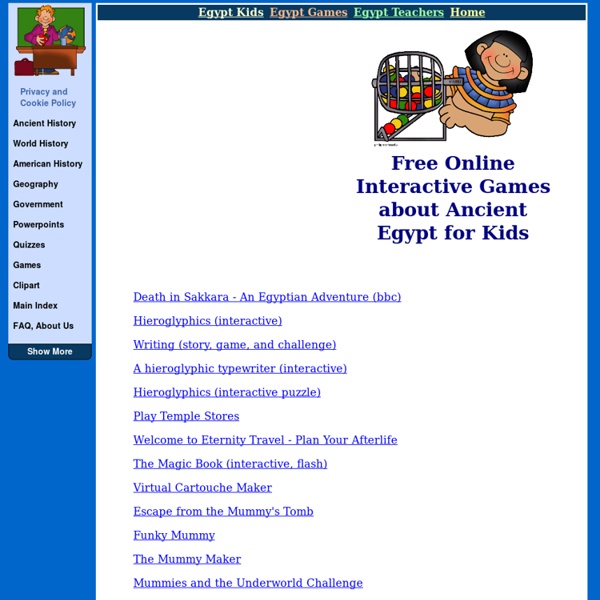



Ancient Egypt for Kids Egyptian Hieroglyphics © Contributed by Leanne Guenther My name is What's your name? It's true that a 7 year old can't learn all the ins and outs of Egyptian hieroglyphics! At times, different words sound the same but mean different things (for example: to and two). Also, keep in mind that the Egyptians didn't always spell from left to right. instead of It's fun to stack and arrange the letters different ways to make the nicest look. We've made our hieroglyphs very colorful, but they were often a lot more dull: Make a cartouche: A cartouche is sort of like a nametag. Arrange your hieroglyphs in this up and down manner on a piece of yellow construction paper or gold wrapping paper. You can try drawing the Hieroglyphs yourself or you can click the template links to print out pictures that you can color in and arrange on your own. Oh, and by the way.
The Egyptian Number System Learn about the Egyptian Number System © 2012 This website is produced by the Student Recruitment, Admissions and International Development Division at The University of Manchester Egipto para niños -materiales- Online Activities As of July 1, 2013 ThinkQuest has been discontinued. We would like to thank everyone for being a part of the ThinkQuest global community: Students - For your limitless creativity and innovation, which inspires us all. Teachers - For your passion in guiding students on their quest. Partners - For your unwavering support and evangelism. Parents - For supporting the use of technology not only as an instrument of learning, but as a means of creating knowledge. We encourage everyone to continue to “Think, Create and Collaborate,” unleashing the power of technology to teach, share, and inspire. Best wishes, The Oracle Education Foundation
Ancient Times This lesson plan may be used to address the academic standards listed below. These standards are drawn from Content Knowledge: A Compendium of Standards and Benchmarks for K-12 Education: 2nd Edition and have been provided courtesy of theMid-continent Research for Education and Learningin Aurora, Colorado. Grade level: 3-5Subject area: historyStandard: Understands selected attributes and historical developments of societies in Africa, the Americas, Asia, and Europe.Benchmarks: Knows about life in urban areas and communities of various cultures of the world at various times in their history. Knows significant historical achievements of various cultures of the world. Grade level: 3-5Subject area: visual artsStandard: Understands the visual arts in relation to history and cultures.Benchmarks: Knows that the visual arts have a history and a specific relationship to various cultures. Identifies specific works of art as belonging to particular cultures, times, and places.
Wheel Of Pharaoh This lesson plan may be used to address the academic standards listed below. These standards are drawn from Content Knowledge: A Compendium of Standards and Benchmarks for K-12 Education: 2nd Edition and have been provided courtesy of theMid-continent Research for Education and Learningin Aurora, Colorado. Grade level: K-4Subject area: HistoryStandard: Understands selected attributes and historical developments of societies in Africa, the Americas, Asia, and Europe.Benchmarks: Knows significant historical achievements of various cultures of the world (e.g., the Hanging Gardens of Babylon, the Taj Mahal in India, the pyramids in Egypt, the temples in ancient Greece, the bridges and aqueducts in ancient Rome). Grade level: 5-6Subject area: Historical understandingStandard: Understands the historical perspective.Benchmarks: Understands that specific individuals had a great impact on history.